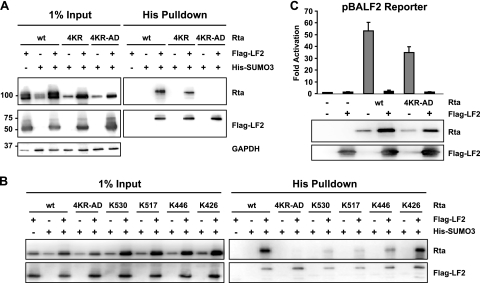FIG. 1.
LF2-dependent sumoylation of Rta is not essential for repression of Rta by LF2. (A) Sumoylation assay to detect SUMO3 modification of Rta (wild type [wt]), Rta K19R K213R K316R K517R (4KR), or Rta K426R K446R K517R K530R (4KR-AD) in the presence of Flag-LF2. Western blotting with anti-Rta antibodies (upper panels) demonstrated the levels of SUMO3-modified Rta or Rta mutants in the presence of Flag-LF2. Input lysates (1%) for pull-down assays are shown in the left half of each panel. Western blotting using anti-Flag antibodies revealed bands corresponding to SUMO3-modified LF2 (lower right panel). (B) Sumoylation assay to detect SUMO3 modification of wt Rta, Rta 4KR-AD, Rta K426R K446R K517R (K530), Rta K426R K446R K530R (K517), Rta K426R K517R K530R (K446), or Rta K446R K517R K530R (K426). Western blotting with anti-Rta antibodies (upper panels) demonstrated the level of SUMO3-modified wt Rta or Rta mutant in the presence of Flag-LF2. Input lysates (1%) for pull-down assays are shown in the left half of each panel. (C) Reporter assay results from 293T cells transfected with a BALF2 promoter-driven luciferase reporter construct with or without Rta or Rta 4KR-AD in the presence or absence of Flag-LF2. Luciferase activities are shown as fold activation over reporter alone and were normalized for transfection efficiency as determined by β-galactosidase activity. Data are averages for six transfections from three independent experiments. Error bars indicate standard deviations. Western blot assays of the cell lysates with anti-Rta and anti-Flag antibodies demonstrated Rta and LF2 protein expression levels.

